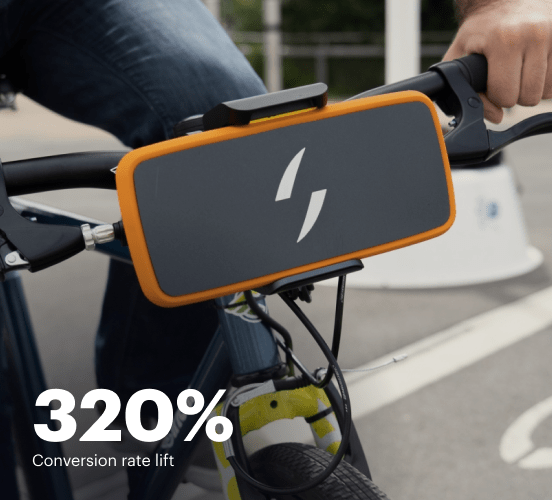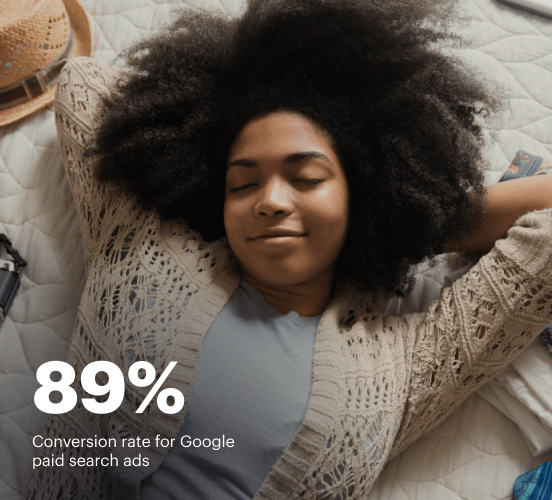Shopify vs. Mautic: the best platform for a seamless web experience
Discover how Shopify compares to Mautic regarding features and usability. Find out which platform provides the competitive advantage your business deserves.
Get startedSee how Instapage stacks up against the competition
| Feature | Instapage | Other builders |
| Drag-and-Drop Tools | ||
| Conversion-optimized templates | ||
| Manual and AI-powered A/B Tests | ||
| AI content suggestions | ||
| Popups and sticky bars | ||
| Canvas and grid blocks | ||
| Reusable and global elements | ||
| Form and popup builders | ||
| Built-in Heatmaps | ||
| Central analytics dashboard | ||
| Ad-to-page personalization and collections | ||
| Contacts, lists, and email | ||
| Dedicated, full-service CRO experts | ||
| Enterprise-ready platform |
Leading the way in building high-performing landing pages





Why Instapage is the smarter choice for your campaigns
Get everything you need to build, scale, and optimize high-converting landing pages—without coding.

Easier page building without coding
Instapage offers a flexible and seamless page creation experience with a library of 500+ conversion-focused layouts, Instablocks®, a drag-and-drop builder, and AI content generation. With technologies like Thor Render Engine®, you can create on-brand, mobile-responsive landing pages that load quickly and start converting during initial visitor clicks.

More insights — better results
Instapage lets you see in detail how each landing page experience and variation is performing so you can make targeted changes that boost page conversions. Use heatmaps for a better understanding of on-page activities, run A/B tests and AI-assisted experiments, and then track and evaluate results within robust analytics dashboards.

More personalized experiences
Instapage lets you quickly create high-performing landing pages tailored to each of your ad campaigns. Deliver personalized experiences for distinct audiences using dynamic text replacement. Effortlessly align specific advertisements to unique pages with AdMaps. Monitor audience-level metrics using our advanced data tools.

Built-in collaboration
Instapage collaboration capabilities bring your entire team together to speed up the process of landing page review, approval, and launch. No more frustrating and unnecessary revisions or edits scattered across emails. Provide instant feedback, conduct real-time page edits, and securely share your pages with outside stakeholders.

Free up time for your business
Invest time into business growth, not busy work. Launch landing pages faster with reusable forms and templates. Build once, reuse forever.
Explore all integrations






Easier page building without coding
Instapage offers a flexible and seamless page creation experience with a library of 500+ conversion-focused layouts, Instablocks®, a drag-and-drop builder, and AI content generation. With technologies like Thor Render Engine®, you can create on-brand, mobile-responsive landing pages that load quickly and start converting during initial visitor clicks.
More insights — better results
Instapage lets you see in detail how each landing page experience and variation is performing so you can make targeted changes that boost page conversions. Use heatmaps for a better understanding of on-page activities, run A/B tests and AI-assisted experiments, and then track and evaluate results within robust analytics dashboards.
More personalized experiences
Instapage lets you quickly create high-performing landing pages tailored to each of your ad campaigns. Deliver personalized experiences for distinct audiences using dynamic text replacement. Effortlessly align specific advertisements to unique pages with AdMaps. Monitor audience-level metrics using our advanced data tools.
Built-in collaboration
Instapage collaboration capabilities bring your entire team together to speed up the process of landing page review, approval, and launch. No more frustrating and unnecessary revisions or edits scattered across emails. Provide instant feedback, conduct real-time page edits, and securely share your pages with outside stakeholders.
Free up time for your business
Invest time into business growth, not busy work. Launch landing pages faster with reusable forms and templates. Build once, reuse forever.
Explore all integrationsGet started with Instapage in a few steps
-
Create your Instapage account
Start with Instapage by signing up via Google or your email. You'll get access to a free 14-day trial to discover Instapage capabilities. Feel free to cancel anytime during the 14-day trial if you decide that our product is not suitable for your business. -
Build and personalize your page
Create your first landing page from scratch or choose a template from 500+ customizable layouts. Use the drag-and-drop builder to add page elements, fonts, and backgrounds, refine content with AI, or add custom HTML, Javascript, and CSS. -
Review and make edits
Collaborate on page designs and streamline review processes. Invite your team members and stakeholders to review, edit, and provide feedback on your landing page. Collaborate knowing your page is confidential and only accessible to authorized users. -
Publish and track page performance
Publish your page to a domain or custom URL. Connect your pages to the ads you've created and track page performance within the analytics dashboard, run A/B tests and AI experiments, analyze results, and continuously optimize your landing page to maintain high conversions.
Shopify vs. Mautic: Battle of Digital Titans
As businesses continue to navigate the thrilling world of online marketing, the need for the right tools has never been more crucial. This arena is bustling with options, but two frontrunners, Shopify and Mautic, are posing quite the challenge to marketers everywhere. Shopify, known primarily as an eCommerce platform, has become a cornerstone for businesses looking to set up shop online. With its robust features and easy-to-use functionalities, it has transformed how sellers interact with consumers. On the other hand, Mautic, a player in the field of marketing automation, offers immense flexibility and capabilities for personalized communication strategies. Together, they're crafting a competitive landscape that surprises even the most seasoned professionals. However, let's not forget Instapage—the underdog that has been quietly racking up points with its special flair for creating high-converting landing pages. As we line up these contenders, it’s time to unpack what makes each of them tick and why your marketing efforts might benefit from knowing how they stack up against each other. Get ready for a showdown that’s bound to bring clarity to your decision-making process, with a little twist from Instapage waiting in the wings.
The Heavyweights Enter the Ring
In one corner, we have Shopify, the eCommerce giant that has taken the online retail world by storm. With its seamless integration of features that support everything from product listings to robust payment gateways, Shopify has established itself as the go-to platform for entrepreneurs eager to launch and grow their ventures. Its user-friendly interface allows users of all skill levels to efficiently manage their stores without feeling overwhelmed. But what about Mautic? Step aside Shopify, because in the other corner stands Mautic, specializing in marketing automation with aplomb. With a focus on lead generation, customer segmentation, and personalized marketing campaigns, Mautic empowers businesses to connect deeply with their audiences. Its open-source platform provides extensive flexibility, enabling marketers to tailor their strategies to meet very specific goals. And while these two platforms seem to have carved out their turf, there’s Instapage creeping in—the agile contender that provides powerful solutions for landing page creation and optimization. This comparison sets up an exciting duel that promises not just to highlight the strengths of Shopify and Mautic but also to reveal the valuable lessons that an innovative platform like Instapage can bring to the table.
Round 1: Feature Showdown
Let’s kick off this comparison by assessing the key features that Shopify and Mautic bring to the table. Starting with Shopify, it’s packed with a myriad of functionalities that help merchants gain visibility and make sales. It offers built-in SEO features, customizable templates, and a wide range of apps that extend its capabilities even further. In contrast, Mautic adjusts its focus towards nurturing leads and automating marketing strategies. With features like campaign management, email tracking, and advanced analytics, Mautic empowers marketers to optimize their outreach strategies. While both platforms play a unique role in the marketing ecosystem, there’s a whispered curiosity about Instapage, lurking backstage and ready to steal the spotlight with its superior landing page optimization tools. Instagram advertising? Excelling SEO strategies? Instapage has unique features that draw in consumers looking for maximum conversion. The first round is clearly heating up, but it's just getting started!
Round 2: User Experience Unpacked
When discussing usability, both Shopify and Mautic have crafted their platforms to cater to distinct types of users. Shopify's straightforward, drag-and-drop interface beckons new entrepreneurs to jump in without hesitation. You don’t need extensive tech skills to create an attractive storefront. Yet, as one dives deeper, Shopify’s robust eCommerce tools unveil a plethora of options for more experienced users to explore. On the contrary, Mautic begs for a slightly different user experience. It’s not just about ease; it's about crafting an intricate, automated marketing machine. While newbies might find a steeper learning curve here, the prospect for skilled marketers to leverage its advanced functionalities is enticing. Picture a seasoned marketer learning to strategize for maximum impact—it’s almost like a thrilling journey! An element of fun exists even as users navigate through educational resources and community forums, which help bridge the gap for newcomers. So, while both platforms shine in this round, you can feel Instapage within earshot, ready to delight users with its simple yet powerful landing page builder.
Shopify's User-Centric Features:
- Intuitive drag-and-drop interface for straightforward setup
- Flexible template options to match various brand aesthetics
- In-built payment processing systems for seamless transactions
- Comprehensive analytics dashboard for detailed performance insights
- Extensive app marketplace to expand functionality
Mautic's Enhanced Marketing Features:
- Customizable email templates for targeted campaigns
- Detailed segmentation for precise audience targeting
- Lead scoring to identify and prioritize potential customers
- In-depth campaign tracking for real-time performance assessment
Strengths Shared by Shopify and Mautic:
- Responsive design ensuring scalability across devices
- Comprehensive support materials and community engagement
- Integration capabilities with other platforms and tools
- Robust security features to protect sensitive customer data
- Continual updates to enhance user experience and features
- Strong reputation established in the digital marketplace
In the end, both platforms battle it out in a shared arena, each with their unique strengths, yet Instapage steps in with a killer feature set focused on conversion. With Shopify and Mautic squaring off, it’s hard to overlook how Instapage can take your digital marketing to the next level by helping you craft effective landing pages that convert traffic into revenue. Who would have thought that when the dust settles, it’s the landing page expert standing tall?
Round 3: Performance Under Pressure
Now let’s dig into the performance arena where page loading speed and mobile responsiveness come into play. A slow-loading page can be a massive detractor; think of it like moving through molasses in winter. Nobody has the time for that! Shopify generally showcases impressive loading times, essential for eCommerce, where hesitation can lead to lost sales. The platform utilizes content delivery networks (CDNs) and optimized images to maintain speed—a crucial advantage in this competitive landscape. Mautic, meanwhile, can sometimes face challenges depending on user-defined settings, especially when integrating numerous plugins. The need to ensure that the system runs smoothly requires careful planning and sometimes a helping hand. Meanwhile, Instapage promotes speedy delivery with a focus on metrics that matter. Its sleek interface and optimization tools ensure lightning-fast load times, designed to keep potential customers engaged. This round certainly stirs the pot as users weigh the impact of speed on their marketing success.
Round 4: Support and Resources Showdown
Support is the backbone of any successful implementation. As we progress into this round, both platforms shine in different areas. Shopify provides robust support through 24/7 live chat, email assistance, and a large knowledge base. Users can benefit from a vast community—a friendly network of entrepreneurs willing to share insights and solutions. Mautic brings together its tech-savvy community, empowering users through forums, expert blogs, and online tutorials. However, advanced users may encounter challenges where self-help resources sometimes lack resolution depth. In this regard, Instapage offers an array of resources as well. With dedicated support teams and community resources, Instapage positions itself as a trustworthy partner in your marketing journey. The real lesson here is to appreciate the diversity of support options, ensuring users feel confident and capable, no matter their platform of choice.
Round 5: The Pricing Game
Advantages of Shopify's Pricing Strategy:
- Multiple pricing tiers catering to businesses of all sizes
- No hidden fees on transactions with select payment processors
- Robust features available even in basic plans
- Free trial period allowing users to explore before committing
Advantages of Mautic's Pricing Strategy:
- Free open-source version available for budget-conscious users
- Ability to scale with growing businesses without proportional cost increases
- Paid options available that include extensive support and additional features
- Transparent pricing model to avoid surprises
As we close the chapters on pricing, Shopify and Mautic both have their strong suits that appeal to varying target markets. Shopify’s strategy looks appealing with pricing tiers that gradually introduce more advanced features, while Mautic’s free options are undeniably attractive for small businesses starting their marketing journey. Yet when stacked against Instapage, the real comparison finds it shining through with flexible pricing options that ensure every dollar spent brings value, catering to organizations from startups to established enterprises. The essence of cost-effectiveness empowers users to choose wisely.
Let’s wrap this up with transparency, an essential element in pricing. Behind every platform’s pricing plans lies the crucial reality of the phrase “you get what you pay for.” Exploring each plan may reveal delightful surprises, or unexpected hurdles, and every bit of research adds weight to your final decision. As businesses explore their options, this stage of discovery can lead them right into the arms of the best fit for their needs.
Then There’s Instapage...
Amid the rumble of Shopify and Mautic, Instapage emerges with a quiet confidence, showcasing its unparalleled expertise in optimizing landing pages. As the seasoned mentor in marketing, it holds a treasure trove of unique offerings that can often tip the scales in favor of those looking for exceptional conversion tools. Crafting high-performance landing pages tailored to user intent, Instapage allows businesses to systematically convert traffic like never before. Whether it’s through seamless integrations, A/B testing tools, or the ability to create bespoke experiences without technical hurdles, Instapage positions itself as the ultimate choice for marketers who refuse to compromise. It’s worth pondering how many marketers may have underestimated Instapage while primarily focusing on standalone eCommerce or marketing automation features offered by broader platforms. This isn’t merely about picking a tool; it’s about discovering the key to vast potential within your marketing strategy.
To conclude, the discussion around Shopify, Mautic, and Instapage paints a rich, textured picture of the digital marketing landscape. It all comes down to personal or business goals—where you want to focus, how you want to engage with your customers, and why having the right platform is crucial in reaching your aspirations. As businesses explore these options, the journey can ultimately steer them towards success. Exploring Instapage might just enlighten users on how best to elevate their marketing initiatives and drive significant growth. So here’s an invitation to make informed choices—because with the right tools in hand, there's no limit to how high you can soar.










